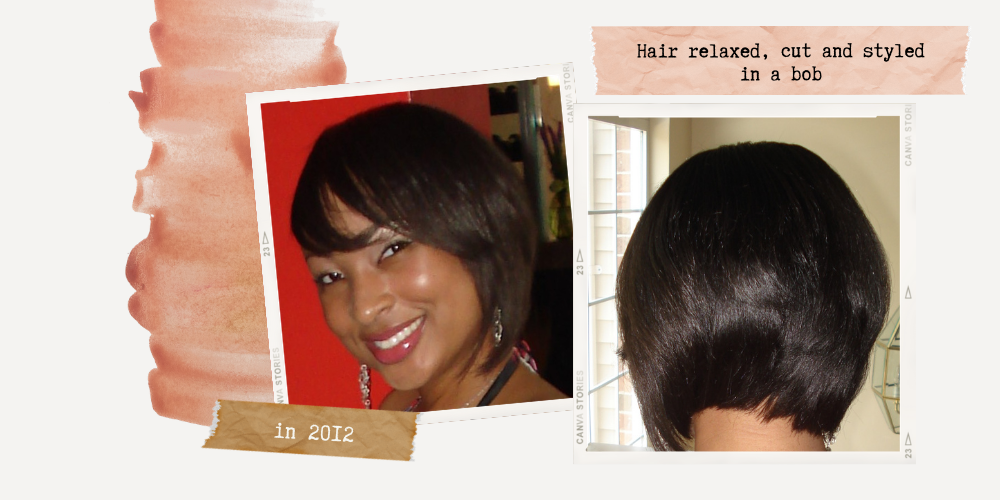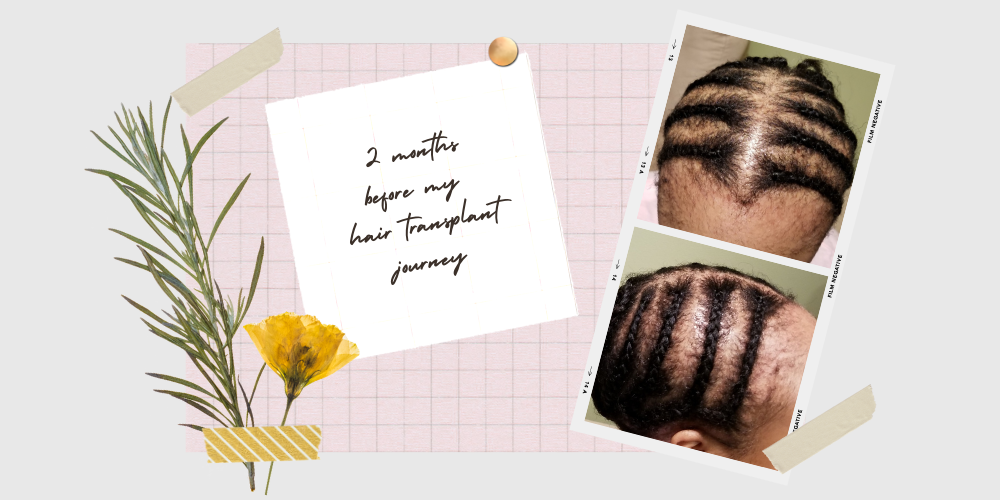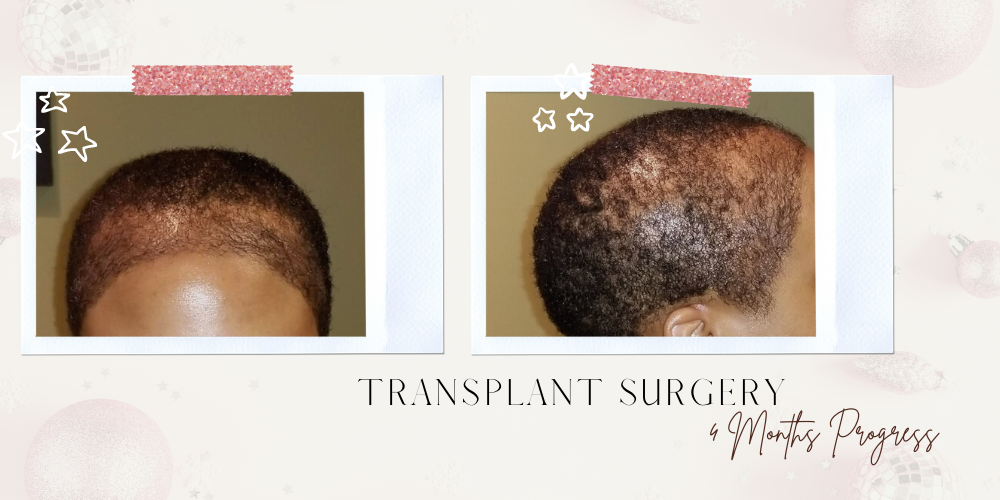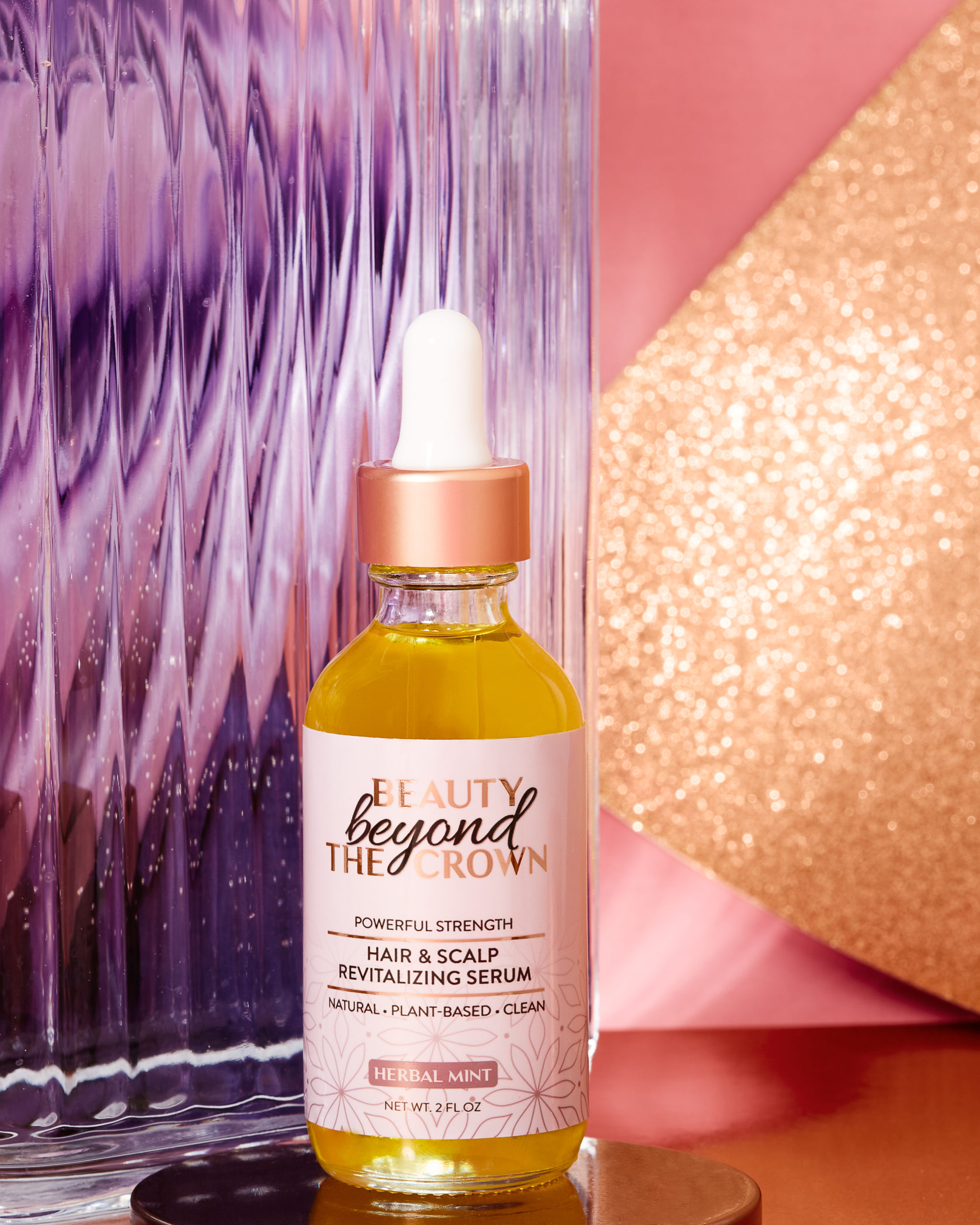My Alopecia (Hair Loss) Story

Before my Alopecia (Hair Loss)
In the summer of 2006, everything was going as expected. My hair was finally growing to a satisfactory length past my shoulders or at least that’s what I thought. I had determined enough was enough of overly processing and dyeing my hair. With truly damaged hair I knew I needed a protective hairstyle that coincided with my lifestyle. I remembered braids were fun, but it took eight hours to install. Plus, I couldn’t handle braids hugging tightly around my edges. So instead, I opted to wear hair extensions. All of the complaints I heard from others about their dilemma with wearing hair extensions, I didn’t experience at all. In fact, once I kept my hair in cornrows (braided flat), washed it once or every two weeks, and applied hair oil to my scalp…I saw a huge difference in my hair growth and had no idea alopecia was in my near future.
At this time, texturizers were used after my hair extensions were removed. This process allowed me to comb through and maintain my natural hair with ease without making the process dreadful. My routine was to keep my hair extensions installed for 2.5 to 3 months with washes in between and saw my edges thicken over time. Grinning from ear to ear I captured a ton of pictures I had to share with my friends.
In this moment I was on the right track and would continue this hair regimen until late fall of 2007. I sat in my doctor’s (Gynecologist) office for my yearly check-up and she suggested I try a new birth control named Yaz. She was an advocate for it and marketed its great benefits such as, lighter and shorter monthly menstruation cycles, and minor to no cramps. What woman wouldn’t want this, right? At that time, I used Mononessa .25-35 mg-mcg birth control to regulate my monthly menstruation cycles and to prevent acne.
The beginning of my Alopecia (Hair Loss)
A couple of months passed and I noticed my edges were thinning, but again didn’t put a lot of thought into it since I wore hair extensions. I waited a little too long to have the extensions removed in February 2008. As my hair stylist carefully removed my hair extensions, there was complete silence and a sudden question, “What happened to your edges and your hair?” I couldn’t comprehend until I saw my natural hair on the floor which had shed from the root of my scalp. I literally didn’t recognize myself in the mirror. The lack of density and volume was no longer there, my hair was three different lengths, and my edges completely vanished. She asked, “What did you change, what did you do differently, and are you taking a new medication?” I was completely oblivious to what might have changed. She proceeded with my routine hair extension install and I was on my way out of the door afterward.
For two weeks I pondered on these questions and returned to my hairstylist with an answer during my next appointment. I realized and informed her the only thing that changed was my birth control. A couple of days later, I followed through with a phone call to my GYN and explained I was experiencing an adverse effect from the Yaz birth control and my hair had fallen out. To my surprise, she mentioned Yaz birth control didn’t have any known side effects and this is the first she’s heard of it. I explained that I wanted to revert back to the previous birth control and I thought this would fix the issue. I was wrong. My problem didn’t go away, it only intensified. For other reasons, I didn’t return to her office, besides I was in the process of moving to another city and state.
My quest to figure out what was happening to me.
I moved to Jacksonville, NC in October 2008 and I was under a lot of duress from being unemployed and other personal matters. Most of this time I was home-sick, stressed, depressed, and fatigued. Low and behold my hair was still shedding, edges were completely gone, my voice was slightly raspy, my nails were brittle, and acne was more prevalent than ever before. Failing to take care of myself, these symptoms continued into the summer of 2009. I shared my symptoms with my mother and she suggested I get tested to ensure I didn’t have an endocrine issue. So, I scheduled an appointment with my nurse practitioner. My lab results were returned a week or so later and he explained it was abnormal and I needed to schedule an appointment with an Endocrinologist for further analysis. This doctor was an hour’s drive away, but I knew it was imperative to find out more.
During my office visit with the Endocrinologist, I explained to her my symptoms and we moved forward with more lab work. I waited over a week for my results and returned to her office for a thorough explanation. Unfortunately, I was diagnosed with an auto-immune condition named Hashimoto’s which is a form of Hypothyroidism. My testosterone hormone had increased twice the limit for a woman on birth control and my iron and vitamin D levels were very low. I have been prescribed Synthroid 75 mcg (taken once daily in the morning an hour before a meal), a different birth control named Demulen 1/35 to block the male hormone testosterone, and a high dose of iron and vitamin D to stabilize me.
I was instructed to continue with this regimen for three months and return for more lab work. What did any of this really mean for me? Was I supposed to take medication forever? My new lab results were returned and all of my hormones seemed to have stabilized and my doctor didn’t need to titrate my medication. Honestly, I felt better, but not completely back to normal. I was still feeling home-sick and depressed, but I carried on and tried to move on through life. I didn’t see any signs of new growth around my edges, but the hair shedding had subsided, or at least for the time being.
Pictures of my hairline loss around my edges.

In 2010, I scheduled an appointment with a local Dermatologist in Jacksonville, NC. I was prescribed Clobetasol Propionate Topical solution for a while and then switched to an ointment formula. I didn’t notice a significant change so Rogaine was recommended. I tried the Men’s Rogaine 5% (Minoxidil) foam for five months and saw progress, but unwanted hair grew in places where I wasn’t expecting so I chose to use the Women’s Rogaine 2% (Minoxidil) for six months. I knew I didn’t want to use Rogaine forever and needed a permanent solution so I visited my Endocrinologist again and she prescribed me Spironolactone 50 mg twice daily to assist with the growth of my edges. Unfortunately, I experienced an adverse reaction. My hair shed profusely over weeks and once I stopped taking the medication the shedding stopped. After this experience, I was so desperate I returned to the Men’s Rogaine 5% for a few months.
Pictures from the result of Men’s Rogaine and Spironolactone.

I began to look into other options such as a hair transplant, but in 2011 there weren’t a plethora of doctors well-versed in African American/black hair and particularly coarse/coily hair (type 4). I decided to put this idea on the back burner. I continued to relax my hair and wear wigs until 2012. Around the same time, I moved to the DC metro area and found a stylist who suggested I cut my damaged hair and style it in a bob. I reluctantly agreed, but it was actually not a bad idea in the end. The result was really nice and I wore this style for approximately a year. I was able to conceal my problem areas by combing my hair in various ways.
Pictures of my hair relaxed, cut, and styled in a bob.

A permanent solution was all I wanted.
The year 2013 approached and I felt as if I needed a different look and didn’t want to wear wigs anymore, so I went back to the hair extensions. What was I thinking? I thought I could somehow magically reverse the problem by camouflaging my condition with hair extensions. I wrestled with this thought process until 2017. During this time, I completely stopped wearing hair extensions because my hairline was non-existent and my hair overall was fragile. Next, I discontinued texturizers and relaxers as a process of elimination so that I could focus on the issue. Then I wore my hair braided down flat in cornrows and was able to comfortably wear my wigs. I can honestly say, wigs have certainly come a long way and I found some attractive ones that worked for me.
I didn’t want to give up searching for a permanent solution, so I scheduled an appointment with another Dermatologist in Arlington, VA. He prescribed me Topicort (Desoximetasone) Topical Spray .25% and I used it intermittently for about nine months, but I didn’t see any progress. At my next visit, I asked to move forward with a scalp biopsy and the final diagnosis was probable scarring alopecia. I wasn’t completely satisfied with this diagnosis and scheduled an appointment with Johns Hopkins Dermatology office in November 2017. This dermatologist gave me steroid injections (Kenalog 10, 30 ml) in my scalp on two different occasions. She also prescribed Clobetasol Propionate Ointment, USP 0.05% three times a week for four months to assist with inflammation. After not seeing major results, she prescribed Metformin cream and I used it for three months. In February 2018, she re-examined the scalp biopsy slide from the previous Dermatologist. After three weeks, my results were in and my diagnosis read….focal derma fibrosis is present and definitive features of a scarring process are not seen. This was good news to me that I didn’t have scarring alopecia and I was finally ready to embark on a hair transplant journey.
Pictures of 2 months before my hair transplant journey.

Finding a permanent solution I felt good about.
I researched hair transplant doctors specializing in black/African American hair and I found Dr. Matt Huebner at Natural Transplants located in Fort Lauderdale, FL. I watched several YouTube videos and listened to patients’ stories, and follow-up results. A video call was scheduled, and I spoke with Dr. Huebner and felt comfortable about the process. Here are 8 quick tips to consider and a list of top 36 questions I asked before making my final decision for a hair transplant surgery. After speaking with the doctor, it was determined I was considered a candidate for the HUE (High-Yield Unit Extraction); in other words, FUT/strip transplant. It’s imperative to know if you have a form of scarring alopecia, there is a strong possibility a hair transplant may not be successful, so it’s vital to have a scalp biopsy performed first. I moved forward with my surgery date scheduled for May 16, 2018 and submitted my deposit. The most important step was following the pre and post-op surgery instructions provided by the doctor.
I flew into Fort Lauderdale, FL on May 15, 2018, to meet Dr. Huebner, reviewed the procedure, and received a written pain medication prescription. The following day, I had my hair transplant surgery and I was super nervous because I wanted everything to go smooth without any hiccups. As I sat in the chair with many thoughts running through my mind, but relaxed after a few minutes. I felt the shots administered to numb my scalp, but this process went fairly quickly. I fell asleep intermittently throughout the procedure which took approximately 6 hours. Once it was over, I returned to my hotel room and took the pain medication prescribed, and relaxed. I only experienced minor swelling around my head, but that subsided after two weeks. I made one last visit post-surgery the following day to Dr. Heubner’s office before I flew home. The sutures were removed after two weeks at a local medical facility in the DC metro area and I continued to use Neosporin in the donor and implant areas.

After four months, I actually saw new hair growth and I was ecstatic. However, I realized after 12 months of new hair growth, I didn’t have as much donor hair as I would have liked to yield greater results. My donor hair (in the very back of my head) overall was sparse. In the future, I will need to have another surgery to complete the look I desire. Almost three years (2021) post-transplant surgery, I’m pleased with my results.

From the years 2018 to 2020, I thought my fears were over and I began to notice a new problem area with my hair. My hair was thinning throughout the center of my scalp and it wasn’t the result of tight braids or hair relaxers, so I opted for a second scalp biopsy. I scheduled an appointment in January 2020 with my Dermatologist from Johns Hopkins and my diagnoses were Central Centrifugal Cicatricial Alopecia (CCCA) and Androgenic/Androgenetic Alopecia. At that moment, it dawned on me that maybe I was experiencing what other women in my family endured for at least four generations, and that was hair loss throughout their top crown. I couldn’t believe it was happening to me at my age. I was still young and full of life and didn’t want to add this to the laundry list of my worries.

My solution for Alopecia (hair loss)
I will admit, I was a little perturbed about my alopecia. Yet, I didn’t want to give up once again on finding a remedy to properly manage my hair and scalp issues. I researched various essential and botanical oils to create a hair growth and scalp serum. I used it on myself for a few months and noticed new hair growth which overall made my hair stronger and healthier. Family and friends with similar conditions tried my product and gave their honest feedback. Their results were amazing and varied. To find out more, click here for a product description in addition to before and after photos.
Beauty Beyond the Crown Hair and Scalp Revitalizing Serum
In conclusion, there were a few factors that caused my alopecia (hair loss). Heredity (at least four generations), the Yaz birth control, environmental elements (e.g. body, hair and face products; toxins in food, pollution in the air, etc.), wearing hair extension excessively for years, stress from unhealthy relationships and demands in life. As a result, these also triggered my Hashimoto’s Hypothyroidism (auto-immune) condition. In recent years, I was diagnosed with focal derma fibrosis without the presence of scarring around my edges (hairline), Androgenic/Androgenetic Alopecia and CCCA throughout the center of my scalp.
I felt compelled to share my story and bring awareness to alopecia (hair loss) for anyone living with it…you’re not alone. I’ve endured alopecia for over 10 plus years now and the road hasn’t been easy. There have been moments of doubt and embarrassment. Instead of being a victim, I chose to become a victor during life’s hardship. I challenge you to become the best version of yourself. Bring forth your own inner beauty, strength, confidence, and uniqueness despite your situation. Read my 8 Quick Tips to Consider Before Having a Hair Transplant and Top 36 Questions to Ask before Having a Hair Transplant blogs. I’m on this journey with you and I’m wishing you many blessings with love, positivity and serenity!



